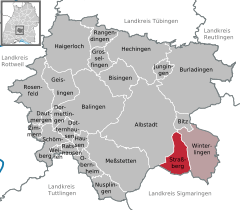Straßberg, Zollernalbkreis
| Straßberg | ||
|---|---|---|
|
Straßberg | ||
| ||
 Straßberg Location of Straßberg within Zollernalbkreis district   | ||
| Coordinates: 48°10′49″N 09°05′16″E / 48.18028°N 9.08778°ECoordinates: 48°10′49″N 09°05′16″E / 48.18028°N 9.08778°E | ||
| Country | Germany | |
| State | Baden-Württemberg | |
| Admin. region | Tübingen | |
| District | Zollernalbkreis | |
| Government | ||
| • Mayor | Markus Zeiser | |
| Area | ||
| • Total | 24.91 km2 (9.62 sq mi) | |
| Elevation | 682 m (2,238 ft) | |
| Population (2017-12-31)[1] | ||
| • Total | 2,460 | |
| • Density | 99/km2 (260/sq mi) | |
| Time zone | CET/CEST (UTC+1/+2) | |
| Postal codes | 72479 | |
| Dialling codes | 07434 | |
| Vehicle registration | BL | |
| Website | www.strassberg.de | |
Straßberg is a municipality in the Zollernalbkreis district, in Baden-Württemberg, Germany.
Within the Heuberg Taining Area there is the legendary Dreibannmarke, also called the "Bahn", a 17th-century border, which today marks the border between three different municipalities, formerly in the three states of Württemberg, Baden, and Hohenzollern. The meadow at the Dreibannmarke served as a stopping place for traveling merchants, wagons and craftsmen. With care it is possible to identify traces of the border. After the inauguration of the firing ranges, a meadow in Meßstetten was allocated as a camping site at the edge of the restricted area. Until 1835 merchants were smuggled over the customs borders guarded by local hunters.
Religions
The following religions are present in Straßberg:
- Roman Catholic Church
- Evangelische Landeskirche in Württemberg before 1950 Kirchenkreis Hohenzollern Evangelische Kirche im Rheinland Old Prussian Mass in Hohenzollern possible by wish.[2]
Notable people
The following list includes notable people who were born or have lived in Straßberg.
- Johann von Werth (1591 -1653) general, married in St.Verena Straßberg 1637
- Katharina Geiger ( 1694-1743) killed, then burned as a witch [5]
- Paul Wilhelm von Keppler (1852-1926) bishop Roman Catholic Church Diözese Rottenburg-Stuttgart, Burg Straßberg
- Hermann Anton Bantle (1872–1930), artist, Beuron Art School
- Claudia Welz (*1974); studied theology and philosophy in Tübingen, Jerusalem, Munich and Heidelberg;habilitation at the Institute for Hermeneutics and Philosophy of Religion, University of Zurich; since 2010 Professor of Systematic Theology since 2014 Director of the Center for the Study of Jewish Thought in Modern Culture at the Faculty of Theology, University of Copenhagen.[6]
References
- ↑ "Bevölkerung nach Nationalität und Geschlecht am 31. Dezember 2017". Statistisches Landesamt Baden-Württemberg (in German). 2018.
- ↑ Antonia Lezerkoss: Kirche: Liturgie nach alter Preußenweise. Südwest Presse Online, 3. Februar 2017, abgerufen am 18. Februar 2018.
Dagmar Stuhrmann: Kirche: Ausstellung „Evanglisch in Hohenzollern“ macht Halt in Ebingen. Südwest Presse Online, 26. Januar 2017, abgerufen am 18. Februar 2018.
Hechingen: Ein Abschied voller Wehmut. Schwarzwälder Bote], 13. Februar 2013, abgerufen am 18. Februar 2018. - ↑ Hegeler, Hartmut. "Namen der Opfer der Hexenprozesse/ Hexenverfolgung in Rottweil" (PDF). Retrieved Sep 19, 2017.
- ↑ NRWZ Verlag Archived 2015-05-25 at the Wayback Machine.
- ↑ Spitzgerte
- ↑ Prof Dr Caudia Welz
.svg.png)